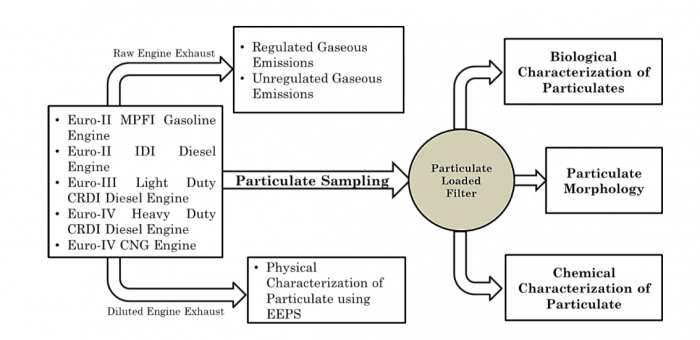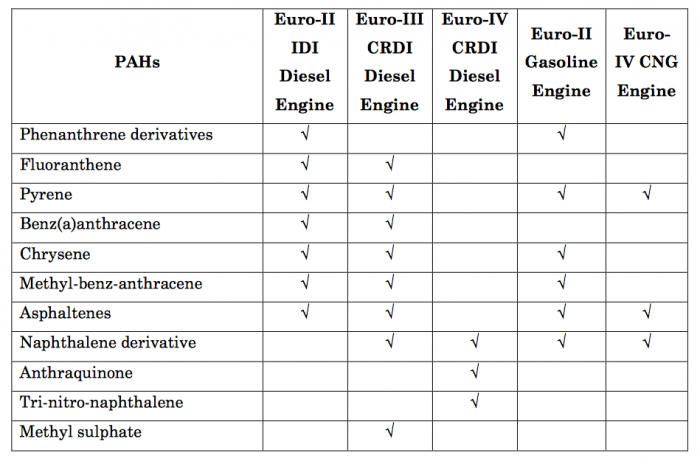
Vehicular pollution is considered to be a major source of ambient air pollution in mega-cities of the world like Delhi.
Exhaust from vehicles is a complex mixture of gases and particulates. The adverse morbidity and mortality effects of these chemical species emitted by engines/ vehicles significantly influence the health of residents of megacities and neighboring satellite towns. Despite intensive research carried out on particulates, a correlation between engine-out particulate emissions and adverse health effects is not well understood yet.
Particulate emissions hold enormous significance for mega-cities that have immense traffic diversity, such as Delhi. Entire public transportation systems involving taxis, three-wheelers, and buses have been switched from conventional liquid fuels to compressed natural gas (CNG) in Delhi. However, after considerably improving the ambient air quality in the city of Delhi since 2001, CNG got a lot of bad press from certain quarters in 2015, wherein claims of higher toxicity of CNG origin particulates were made. From their detailed and comprehensive experimental study, it is proven conclusively beyond any doubt that this bad press to CNG was indeed not based on scientific facts and was a result of poor scientific data without any sound scientific evidence and was driven by ulterior motives.
Exhaustive experiments were carried out by Indian Institute of Technology Kanpur’s prestigious engine research laboratory over three years since 2015 to evaluate cytotoxicity and mutagenicity of particulates emitted by various engines used in different types of vehicles. These engines use a variety of fuels such as gasoline, diesel, and CNG, and use different engine technologies and emission compliances. The objective of this study was to realistically establish the toxic potential and mutagenicity of particulate emissions from different vehicle mixes by exposing human kidney cell lines to these particulates from different engines/fuels. This study is published in the journal Environmental Pollution, in the August 2018 issue.
Prof. Avinash Kumar Agarwal (Mechanical Engineering), Prof. Tarun Gupta (Environmental Engineering) and Prof. Bushra (BioSciences and Bio-Engineering) led a large interdisciplinary team of 10 researchers from IIT Kanpur to resolve this complicated issue and get to the bottom of the scientific riddle. In this study, the engine evaluated represented the mixed set of vehicles plying the roads of a metropolis like Delhi. The engines were having various emission compliances such as Euro-II, Euro-III, and Euro-IV, and they were using different technologies since they are using different fuels namely gasoline, diesel, and CNG. Particulate matter was collected from the emissions emanating from the tail-pipes of these vehicles and then comprehensive tests were conducted by their biological and toxicological analysis in addition to detailed physical, morphological, and chemical analysis using most advanced instruments and techniques, to establish their relative toxicity.

Figure 1: Experimental Study Landscape. Republished with permission from Elsevier from: https://doi.org/10.1016/j.envpol.2018.04.028
Researchers noted the number of fine particles originating from diesel engines was 30-50 times higher compared to CNG engines. These finer particles in the nano-meter sized range are capable of penetrating the deepest parts of the human lungs and eventually get transferred to the bloodstream. Smaller particles have significantly higher surface area than relatively larger particles, hence they provide higher capacity for surface adsorption of PAHs and other volatile hydrocarbon species, which are very harmful to the human health and this increases the toxicity of diesel particulates. CNG engine exhaust particulates exhibited significantly lower surface area compared to particulates emanating from diesel and gasoline engine, therefore CNG particulates have significantly lower cytotoxicity and mutagenicity.

Table 1: PAHs detected in particulates emitted by different test engines using a variety of fuels and emission compliances. Republished with permission from Elsevier from: https://doi.org/10.1016/j.envpol.2018.04.028
The mutagenic potential of particulate samples was investigated at different concentrations using two different Salmonella strains, TA98 and TA100, in the presence and absence of liver S9 metabolic enzyme fraction. Particulates emitted from diesel and gasoline engines exhibited higher mutagenicity, while those from CNG engine showed negligible mutagenicity compared to other test fuels and engine configurations.
Particulate concentrations, as well as hazardous chemical constituents such as transition metals (especially Iron, Copper, and Nickel), were emitted in significantly lower concentrations when CNG was used to fuel the engine compared to the two conventional petroleum-based liquid fuels. Diesel engines emit significantly higher levels of toxic transition trace metals than CNG. Polycyclic aromatic hydrocarbons (PAHs) (carcinogenic organics present in engine exhaust emissions) adsorbed onto CNG engine particulates were also relatively fewer compared to those from equivalent diesel and gasoline engines.
The amount of PAHs reduced as they moved from BS-II to BS-IV engines, even with diesel fuel. A lower number of toxic PAHs emitted by CNG engine indicated significantly lower toxicity of the exhaust emanating from CNG fueled vehicles in mega-cities like Delhi, in contrast to the exhaust emanating from diesel and gasoline-fueled vehicles. However, CNG and gasoline exhaust had nearly 2-3 times higher amounts of formaldehyde (which can cause skin and eye irritation) compared to other test fuels.

Table 2: Qualitative analysis of particulates emitted from different engines. Republished with permission from Elsevier from: https://doi.org/10.1016/j.envpol.2018.04.028
Taken together, their findings indicate that CNG is comparatively safer fuel compared to diesel and gasoline and can offer a cleaner transport energy solution for mega-cities with mixed-traffic conditions, especially in developing countries. Their experimental investigations have conclusively demonstrated that CNG is a cleaner fuel compared to diesel and gasoline, which it aims to displace.
Displacement of liquid petroleum-based conventional fuels with CNG will, therefore, be a significant step in the direction of reducing damage to the health of the exposed population and help reduce the disease burden in these mega-cities. This could certainly be a great example for other mega-cities of the world, which would like to clean up their ambient air quality and associated health impacts of conventional fuels by gradually switching their public transportation system from conventional liquid fuels to CNG.
Overall, particulates originating from conventional liquid fuel operating engines, i.e., diesel and gasoline engines, showed significantly higher mutagenicity than the particulates originating from the CNG engine. It is their desire that the government of India and other policymakers in developing world, who are facing a similar situation of poor ambient air quality, would take a note of this study and take appropriate decisions at promoting this clean fuel CNG for upcoming and existing megacities and clean cities of the world.
These findings are described in the article entitled, Toxicity and mutagenicity of exhaust from compressed natural gas: Could this be a clean solution for megacities with mixed-traffic conditions?, recently published in the journal Environmental Pollution.
This work was conducted by Avinash K. Agarwal, Bushra Ateeq, Tarun Gupta, Akhilendra P. Singh, Swaroop K. Pandey, Nikhil Sharma, Rashmi A. Agarwal, Neeraj K. Gupta, Hemant Sharma, Ayush Jain, and Pravesh C. Shukla from the Indian Institute of Technology Kanpur.









